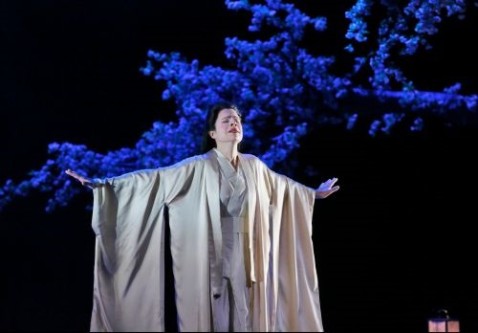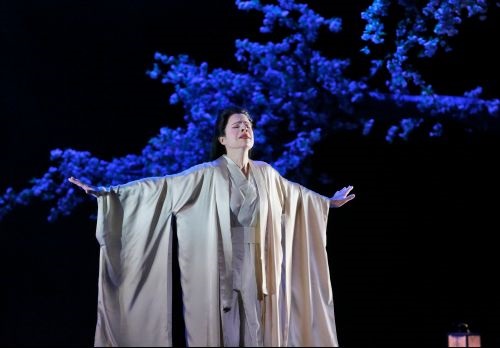 United States Puccini, Madame Butterfly: LA Opera, James Conlon (conductor), Dorothy Chandler Pavilion, Los Angeles, 12.3.2016 (JRo)
United States Puccini, Madame Butterfly: LA Opera, James Conlon (conductor), Dorothy Chandler Pavilion, Los Angeles, 12.3.2016 (JRo)

Cast:
Cio-Cio-San: Ana María Martínez
Pinkerton: Stefano Secco
Suzuki: Milena Kitic
Sharpless: Kihun Yoon
Goro: Keith Jameson
Yamadori: Daniel Armstrong
The Bonze: Nicholas Brownlee
Kate Pinkerton: Lacey Jo Benter
Production:
Director: Lee Blakeley
Scenery Design: Jean-Marc Puissant
Costume Design: Brigitte Reiffenstuel
Lighting Design: Rick Fisher
Chorus Director: Grant Gershon
In LA Opera’s riveting Madame Butterfly, which penetratingly explores the effects of imperialism in early twentieth-century Japan, we have a Butterfly that transcends the domestic and becomes epic in scope. Everything in this new production, created for the Santa Fe Opera, from the sets of Jean-Marc Puissant to the direction of Lee Blakeley to the splendid cast, make this a Butterfly that lingers in the mind and heart.
For his tale of a geisha from an impoverished noble family who marries an American lieutenant and ultimately dies for love, Puccini chose a play by David Belasco based on a story by John Luther Long. What appealed to Puccini was the complexity of Butterfly’s character, so unlike the usual depiction of Japanese “wives for hire” in the popular literature of the day. In 1887, Pierre Loti’s more realistic and cynical story of Madame Chrysanthème established a vogue for pieces set in Japan and, in 1893, spawned a popular opera by Messager. Here Puccini chose an innocent girl of fifteen who fully embraces her role as wife, who is painfully in love with her American husband and imagines herself to be in a traditional marriage.
Ana Maria Martinez as Butterfly was believable as a fifteen-year-old innocent, but what added dimension to the character was her transition, after three years, into a patient and self-sacrificing woman, ennobled by her suffering as she continues to await Pinkerton’s return. In Pinkerton, Stefano Secco found a role that suited him well. He imbued his careless lieutenant with the kind of obsessive lust Humbert felt for his stepdaughter in Nabokov’s Lolita. With Secco’s performance, the seeds of Butterfly’s destruction were planted from the opening scene, and we were swept away on the waves of this tragedy from the very first moment.
The action took place on an exquisite set. Much like the Japanese art of the period, which reflects a European influence, the house, a rectangular structure with movable paper screens, and the landscape, blossoming trees and a full sun on the horizon, combined the minimalist Japanese aesthetic with hints of European culture. Lit with an amber glow at the opening of Act I, it was the perfect backdrop for the marriage of the tender Butterfly and the blustery Pinkerton. The scene’s transition in Act II was cleverly conceived. Telephone poles and wires replaced the graceful cherry trees of Act I, emphasizing the passage of time, the effects of modernization, and the growing poverty of Butterfly and her devoted maid, Suzuki.
Milena Kitic as Suzuki gave a brilliant performance. In voice and spirit she embodied Suzuki, whose sufferings on behalf of her mistress gave true gravity to Butterfly’s hopeless yearnings. One of the highlights of the evening was the ethereal Act II duet of the flowers, “Scuoti quella fronda di cilegio,” as mistress and maid scattered petals on the floor of the house to prepare for Butterfly’s deluded fantasy of Pinkerton’s return.
From his opening duet with Sharpless, movingly sung by a sympathetic Kihun Yoon, to his love duet with Martinez at the end of Act I, Secco’s ringing tenor charged the atmosphere with an electric current that amplified the character and ignited the scenes, even in his absence through most of Act II.
Martinez’s delicate Butterfly gained in force as the evening progressed. Though the quiet passages were sensitively articulated from the first moment, it took time for her voice to ripen in the upper register. Once it did and she shed the reserve of her modest character, she sang a sumptuous love duet with Secco and a vivid “Un bel di vedremo,” one of the most beloved arias in all of Puccini. Her closing aria, as she stabs herself, displayed tragic power.
As Butterfly’s child, five-year-old Nicholas Cuenca Terry was both adorable and heartbreaking. In an interesting twist on the ending, instead of playing with a toy American flag, the boy grabs his mother’s knife and, draped in a full-sized flag, points it at Pinkerton as he enters the house. Does he want to play or is he defending himself against the intruder? It was a provocative conclusion.
James Conlon and the LA Opera Orchestra beautifully conveyed the shifting moods of the score as we sat, hypnotically transported to the Japan of Puccini’s imaginings.
Jane Rosenberg

It was incredibly wonderful!